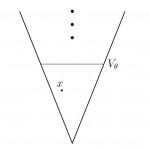 Set-theoretic arguments often make use of the fact that a particular property is local, in the sense that instances of the property can be verified by checking certain facts in only a bounded part of the set-theoretic universe, such as inside some rank-initial segment or inside the collection of all sets of hereditary size less than . It turns out that this concept is exactly equivalent to the property being expressible in the language of set theory.
Set-theoretic arguments often make use of the fact that a particular property is local, in the sense that instances of the property can be verified by checking certain facts in only a bounded part of the set-theoretic universe, such as inside some rank-initial segment or inside the collection of all sets of hereditary size less than . It turns out that this concept is exactly equivalent to the property being expressible in the language of set theory.
Theorem. For any assertion in the language of set theory, the following are equivalent:
- is ZFC-provably equivalent to a assertion.
- is ZFC-provably equivalent to an assertion of the form “,” where is a statement of any complexity.
- is ZFC-provably equivalent to an assertion of the form “,” where is a statement of any complexity.
Just to clarify, the assertions in set theory are those of the form , where has only bounded quantifiers. The set refers to the rank-initial segment of the set-theoretic universe, consisting of all sets of von Neumann rank less than . The set consists of all sets of hereditary size less than , that is, whose transitive closure has size less than .
Proof. () Since is correctly computed inside for any , it follows that to assert that some satisfies is the same as to assert that some thinks that there is some cardinal such that satisfies .
() The statement is equivalent to the assertion . The claim that involves only bounded quantifiers, since the quantifiers of become bounded by . The claim that is in and , since it is equivalent to saying that is transitive and the ordinals of are precisely and thinks every exists, plus a certain minimal set theory (so far this is just , since all quantifiers are bounded), plus, finally, the assertion that contains every subset of each of its elements. So altogether, the assertion that some satisfies has complexity in the language of set theory.
() This implication is a consequence of the following absoluteness lemma.
Lemma. (Levy) If is any uncountable cardinal, then .
Proof. Suppose that and , where has only bounded quantifiers. Fix some such witness , which exists inside some for perhaps much larger . By the Löwenheim-Skolem theorem, there is with , and of size less than . Let be the Mostowski collapse of , so that is transitive, and since it has size less than , it follows that . Since the transitive closure of was contained in , it follows that . Thus, since we conclude that and so hence is a witness to inside , as desired. QED
Using the lemma, we now prove the remaining part of the theorem. Consider any assertion , where has only bounded quantifiers. This assertion is equivalent to , simply because if there is such a with having such an , then by the lemma this works for all since ; and conversely, if there is an such that , then this will remain true inside any with . QED
In light of the theorem, it makes sense to refer to the properties as the locally verifiable properties, or perhaps as semi-local properties, since positive instances of assertions can be verified in some sufficiently large , without need for unbounded search. A truly local property, therefore, would be one such that positive and negative instances can be verified this way, and these would be precisely the properties, whose positive and negative instances are locally verifiable.
Tighter concepts of locality are obtained by insisting that the property is not merely verified in some , perhaps very large, but rather is verified in a where has a certain closeness to the parameters or instance of the property. For example, a cardinal is measurable just in case there is a -complete nonprincipal ultrafilter on , and this is verified inside . Thus, the assertion “ is measurable,” has complexity over . One may similarly speak of or properties, to refer to properties that can be verified with assertions in . Alternatively, for any class function on the ordinals, one may speak of -local properties, meaning a property that can be checked of by checking a property inside .
This post was made in response to a question on MathOverflow.
 Set-theoretic arguments often make use of the fact that a particular property
Set-theoretic arguments often make use of the fact that a particular property 
